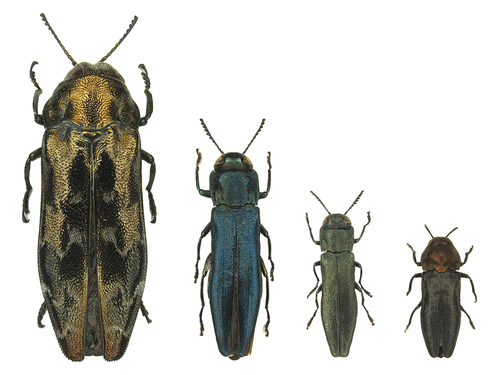
ABELLAN Pedro
- Department of Zoology, Universidad de Sevilla, Seville, Spain
- Biodiversity, Biogeography, Conservation biology, Ecology, Evolution, Insecta
- recommender, manager
Recommendation: 1
Reviews: 0
Recommendation: 1

Intra- and interspecific variations in flight performance of oak-associated Agrilinae (Coleoptera: Buprestidae) using computerised flight mills
A comparative study of flight performance and the factors affecting the flight behaviour of oak-associated Agrilinae (Coleoptera: Buprestidae)
Recommended by Pedro Abellan based on reviews by 2 anonymous reviewersSome insects are known to be phytosanitary threats on a wide diversity of plants and can have important economic and ecological impacts in their native area. This is the case of some species within the jewel beetle subfamily Agrilinae (Coleoptera: Buprestidae), which are associated with broadleaf forest declines and diebacks (Jendek & Poláková, 2014). These thermophilous borers are expected to be favoured by climate change and the global deterioration of forest health, and ultimately expand their range and damage.
Active flight plays a crucial role in the life strategies of most insects, facilitating essential activities such as mate searching, locating trophic resources, finding favorable environmental conditions, and dispersing to or colonizing new geographic areas (Dudley, 2002). Studying flight capacities provides valuable insights into the ecology of these species and helps estimate their ability to spread within new environments. Assessing the flight capacities of pest and alien species is therefore critical for evaluating their dispersal potential and for designing effective monitoring and control strategies.
The study by Le Souchu et al. (2024) aimed to assess intra- and interspecific variability in active flight of several Agrilinae species and to evaluate the effects of sex and mass on this variability. Using computerised flight mills, they assessed the flight performance of twelve species, most of them associated with oaks. A key feature of the study is the extensive dataset used, which reveals significant variability in flight distance and capacity among species and individuals. Body mass positively influenced flight capacity in some species, while no sexual dimorphism was observed. The findings suggest a generally low average dispersal propensity within these species and highlight the critical role of rare, exceptional individuals in driving colonization and spread patterns at both population and species levels.
Overall, the study provides a valuable comparative analysis of flight behavior and performance in several Agrilinae species associated with oak forests. Because flight behaviour and performance of these insects are poorly known despite their critical role in dispersal inside and outside native ranges and their relevance for management purposes, this study contributes to filling this gap. From a broader perspective, the findings revealed several common traits among the studied species and provide insights into the influence of different factors on flight activity.
References
Dudley, R. (2002) The biomechanics of insect flight: form, function, evolution. Princeton University Press, Princeton, N.J. https://doi.org/10.1515/9780691186344
Jendek, E., Poláková, J. (2014) Host Plants of World Agrilus (Coleoptera, Buprestidae). Springer International Publishing, Cham. https://doi.org/10.1007/978-3-319-08410-7
Le Souchu, E., Sallé, A., Bankhead-Dronnet, S., Laparie, M., Sauvard, S. (2024) Intra- and interspecific variations in flight performance of oak-associated Agrilinae (Coleoptera: Buprestidae) using computerised flight mills . bioRxiv, ver.2 peer-reviewed and recommended by PCI Zoology https://doi.org/10.1101/2024.07.01.601558